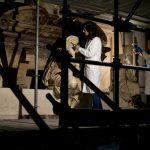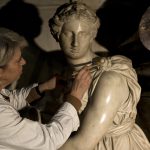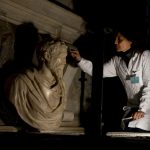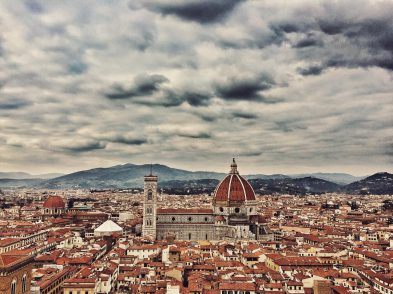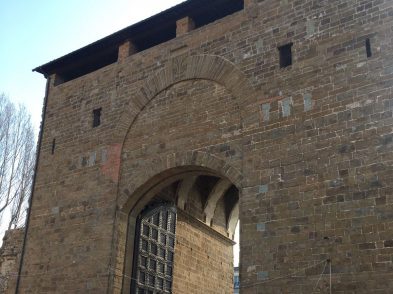- Restoring Michelangelo’s tomb / ph. Dario Garofalo
- Irene Sanesi, president of Opera di Santa Croce (in red); Giuseppe Di Michele, secretary general of Opera di Santa Croce left of Sanesi; the restorers and U.S. donors
- Restoring Michelangelo’s tomb / ph. Dario Garofalo
- Restoring Michelangelo’s tomb / ph. Dario Garofalo
- Restoring Michelangelo’s tomb / ph. Dario Garofalo
The international fundraising campaign by the Opera of Santa Croce In the Name of Michelangelo has completed the first stage of restoration of Michelangelo’s tomb, with the occasion marked by a visit to Santa Croce by a contingent of sponsors from Italy and the United States. The project was financed by over 100 donors from 12 countries, 80 per cent of them U.S. citizens.
Following the last restoration finished 18 years ago, the fundraising campaign started in September 2017 quickly reached its goal with 100,000 euro going towards the cleaning and diagnostics of the tomb. This also includes a thorough restoration of the altarpiece, which had been damaged by the 1966 Florence flood, with this second phase forecast to be completed by the autumn.
The Buonarotti altarpiece and tomb, both based on the designs of Giorgio Vasari, were commissioned by Lionardo Buonarroti, Michelangelo’s heir, responsible for smuggling his uncle’s body from the SS. Apostoli church in Rome for interment in Florence’s basilica of Santa Croce.
The altarpiece depicts Christ meeting Saint Veronica on the way to Calvary and has 60 members of the Buonarotti family buried at its feet. The funerary monument portraying the artist and the three embodiments of the arts (sculpture, architecture and painting) was brought to completion after Vasari’s death by Giovan Battista Lorenzi, Giovanni Bandini, Valerio Cioli and Giovan Battista Naldini. Originally it was Vasari’s intention to place the representation of “painting” at the centre, in keeping with the catafalque created for the funeral held for Michelangelo in the basilica of San Lorenzo. With the approval of Cosimo I de’ Medici, Lionardo Buonarroti decided to move “sculpture” to the centre, in line with his uncle’s expertise.
While necessary, restorations often leave visitors disappointed in the period they are unable to see the exhibits, yet restorers Paola Rosa and Emanuela Peiretti have turned this project into a positive experience by allowing visitors to observe the various phases of work.



